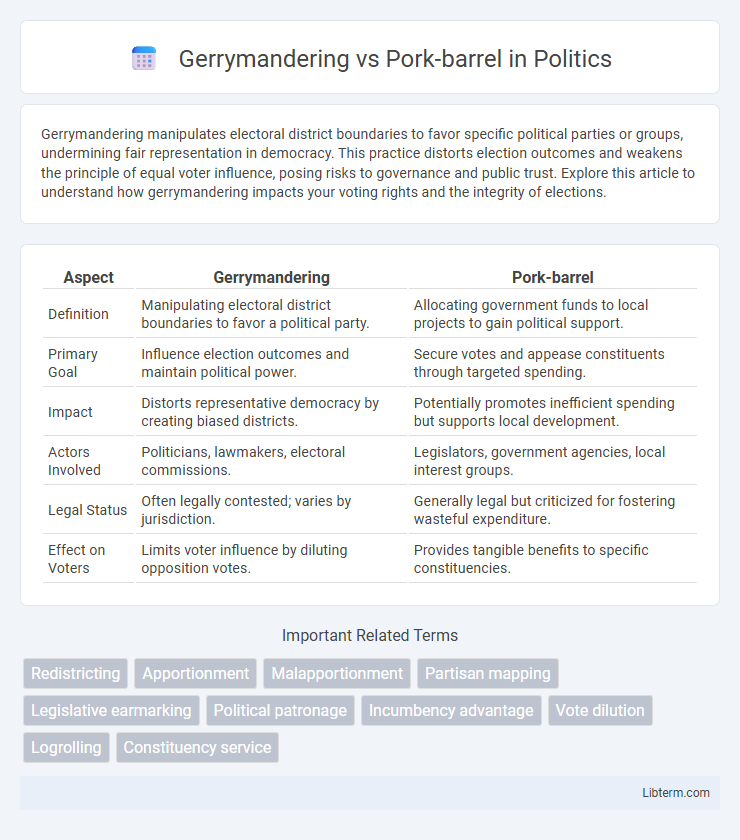Gerrymandering manipulates electoral district boundaries to favor specific political parties or groups, undermining fair representation in democracy. This practice distorts election outcomes and weakens the principle of equal voter influence, posing risks to governance and public trust. Explore this article to understand how gerrymandering impacts your voting rights and the integrity of elections.
Table of Comparison
| Aspect | Gerrymandering | Pork-barrel |
|---|---|---|
| Definition | Manipulating electoral district boundaries to favor a political party. | Allocating government funds to local projects to gain political support. |
| Primary Goal | Influence election outcomes and maintain political power. | Secure votes and appease constituents through targeted spending. |
| Impact | Distorts representative democracy by creating biased districts. | Potentially promotes inefficient spending but supports local development. |
| Actors Involved | Politicians, lawmakers, electoral commissions. | Legislators, government agencies, local interest groups. |
| Legal Status | Often legally contested; varies by jurisdiction. | Generally legal but criticized for fostering wasteful expenditure. |
| Effect on Voters | Limits voter influence by diluting opposition votes. | Provides tangible benefits to specific constituencies. |
Understanding Gerrymandering: Definition and Origins
Gerrymandering is the practice of manipulating electoral district boundaries to favor a particular political party or group, often resulting in distorted representation. Originating from early 19th-century Massachusetts, the term combines the name of Governor Elbridge Gerry with "salamander," describing a district shaped to benefit his party. Understanding the definition and origins of gerrymandering is essential for addressing issues of electoral fairness and democratic integrity.
Defining Pork-Barrel Politics: Key Concepts
Pork-barrel politics involves allocating government funds to local projects primarily to please voters or legislators and secure political support, rather than addressing broader public needs. This strategy often leads to targeted spending on infrastructure, community programs, or public works that benefit specific districts or constituencies. Unlike gerrymandering, which manipulates electoral boundaries for partisan advantage, pork-barrel focuses on budgetary decisions to maintain political loyalty and influence.
Historical Context: Evolution of Gerrymandering and Pork-Barrel
Gerrymandering originated in the early 19th century when Massachusetts Governor Elbridge Gerry approved a redistricting plan favoring his party, leading to oddly shaped electoral districts designed to manipulate election outcomes. Pork-barrel politics traces back to the late 19th century, characterized by legislators securing government funds for localized projects to benefit their constituents and solidify political support. Both practices have evolved with changes in political systems, legal rulings, and public awareness, reflecting ongoing challenges in balancing political strategy and democratic fairness.
Methods and Tactics: How Gerrymandering Works
Gerrymandering manipulates electoral district boundaries to create an unfair advantage for a particular party by concentrating or diluting voter groups, often using tactics like "cracking" to split opposition voters and "packing" to concentrate them into fewer districts. In contrast, pork-barreling involves legislators securing government spending for localized projects to benefit their constituents and gain political support. Gerrymandering's method of altering geographic voter distribution directly impacts election outcomes, while pork-barreling influences voter loyalty through targeted resource allocation.
Mechanisms Behind Pork-Barrel Spending
Pork-barrel spending operates through targeted allocation of government funds to specific districts or projects, often designed to secure political support from local constituents and legislators. This mechanism includes earmarking funds for local infrastructure, public services, or development projects that directly benefit a politician's voter base. Unlike gerrymandering, which manipulates electoral boundaries to influence election outcomes, pork-barrel spending leverages budgetary decisions to maintain political loyalty and reinforce incumbency.
Political Motivations: Comparing Intentions and Incentives
Gerrymandering involves manipulating electoral district boundaries primarily to entrench political power and secure electoral advantages for a particular party or group. Pork-barrel spending targets specific projects within legislators' districts to gain voter support and reinforce incumbency through tangible benefits. Both practices reflect strategic incentives to consolidate influence, yet gerrymandering skews democratic representation while pork-barrel politics focuses on localized resource allocation to bolster political loyalty.
Impact on Electoral Outcomes and Representation
Gerrymandering manipulates electoral district boundaries to create an unfair advantage for a political party, significantly skewing representation and often diminishing the voting power of certain demographic groups. Pork-barrel spending directs government funds to local projects for the purpose of winning electoral support, reinforcing incumbent popularity but rarely altering broader electoral boundaries or outcomes. While gerrymandering reshapes the political landscape structurally, pork-barrel politics primarily influences voter loyalty through targeted resource allocation, affecting representation indirectly.
Economic Consequences of Both Practices
Gerrymandering distorts political representation, leading to policies that favor specific districts rather than economic efficiency, which often results in misallocated public resources and stunted regional growth. Pork-barrel spending directly channels government funds into localized projects that may lack broader economic merit, promoting inefficiency and increasing fiscal deficits. Both practices contribute to economic distortions by prioritizing political gain over sound budgetary and developmental strategies.
Legal Framework: Laws and Court Rulings
Gerrymandering is regulated through laws such as the Voting Rights Act and court rulings like the Supreme Court's decision in Rucho v. Common Cause, which ruled partisan gerrymandering claims non-justiciable. Pork-barrel spending falls under ethical and legislative oversight, governed by rules on appropriations and transparency enforced by bodies like the House and Senate Ethics Committees. Legal frameworks for both practices emphasize maintaining fair representation and preventing misuse of public funds, yet enforcement varies by jurisdiction and political context.
Reform Efforts and Future Challenges
Reform efforts targeting gerrymandering emphasize independent redistricting commissions and algorithm-driven map drawing to ensure fair representation in legislative boundaries. Addressing pork-barrel spending involves increased transparency measures, stricter budgetary oversight, and enhanced public accountability to curtail wasteful or electorally motivated expenditures. Future challenges include overcoming partisan resistance and adapting reforms to emerging political strategies and evolving electoral technologies.
Gerrymandering Infographic

 libterm.com
libterm.com